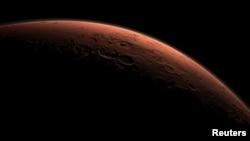Solar winds are slowing stripping Mars of its atmosphere, according to NASA.
Writing in the journal Science and Geophysical Research Letters, researchers say they used data from the Mars Atmosphere and Volatile Evolution (MAVEN) mission to conclude the Red Planet is slowly losing its atmosphere.
“Mars appears to have had a thick atmosphere warm enough to support liquid water which is a key ingredient and medium for life as we currently know it,” said John Grunsfeld, astronaut and associate administrator for the NASA Science Mission Directorate in Washington. “Understanding what happened to the Mars atmosphere will inform our knowledge of the dynamics and evolution of any planetary atmosphere. Learning what can cause changes to a planet’s environment from one that could host microbes at the surface to one that doesn’t is important to know, and is a key question that is being addressed in NASA’s journey to Mars.”
Researchers also said the erosion of the Martian atmosphere “increases significantly” during solar storms.
The MAVEN data indicated that the solar wind robs Mars of about 100 grams of atmosphere every second. This, researchers say “was likely a major process in changing the Martian climate.”
The solar wind is a stream of mostly protons and electrons that travels at 1.6 million kilometers per second.
"Like the theft of a few coins from a cash register every day, the loss becomes significant over time," said Bruce Jakosky, MAVEN principal investigator at the University of Colorado, Boulder. "We've seen that the atmospheric erosion increases significantly during solar storms, so we think the loss rate was much higher billions of years ago when the sun was young and more active.”
Recent missions to Mars indicate the planet once had abundant water, likely kept in liquid form by an atmosphere much more dense than today’s, which is too cold and thin.
The Mars Reconnaissance Orbiter observed that the Red Planet may yet have seasonal liquid water in the form of briny liquid.
MAVEN was launched in 2013.
Here's a video about the study:












